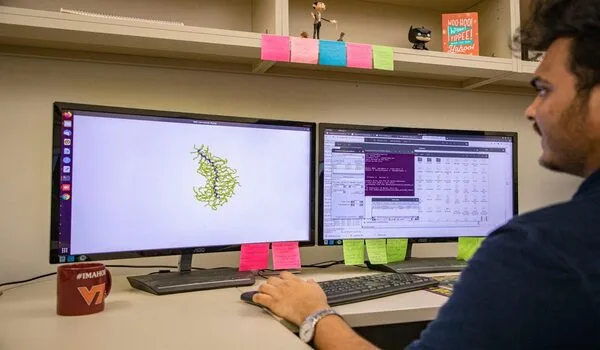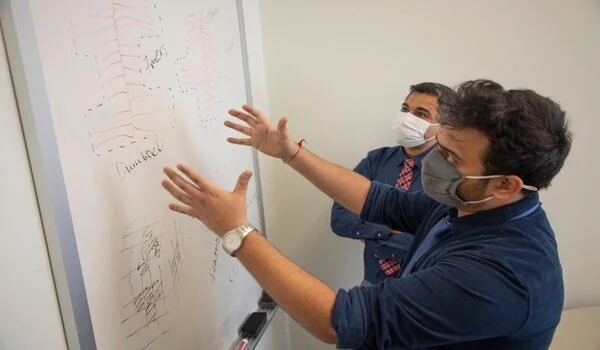New items are frequently the result of innovation, but new approaches can be equally revolutionary.
Soumil Joshi, a chemical engineering PhD student from Mumbai, India, came to Virginia Tech in 2019 because he wanted to help develop those technologies.
“It’s a terrific institution, especially for the chemical engineering profession, and it’s well-known for polymer research, which I’m grateful to be doing here,” Joshi said.
In March, he was named first author of a paper presenting a new computational method for working with polymers, which he and his advisor, Assistant Professor Sanket Deshmukh, think could lead to substantial biomedical advances.

The paper, “Coarse-grained molecular dynamics integrated with Convolutional Neural Network for comparing shapes of temperature-sensitive bottlebrushes,” describes a method developed by the Deshmukh lab, which includes co-author and visiting scholar Samrendra Singh, that employs artificial intelligence to analyze the shape of important complex soft materials and predict their behaviors.
It was published in Nature’s open-access journal npj Computational Materials, and it not only offers promise for enabling new discoveries in biomaterials, but it also underlines the expanding relevance of big data, artificial intelligence, and computational science in chemical engineering.
Deshmukh believes that computer-assisted innovations are crucial to making advancements in a variety of disciplines. Because there are long-standing scientific problems that cannot be solved by present methods, problem solving and the development of new methods go hand in hand.
“There are long-standing scientific problems that can’t be solved by existing methods, so solving problems and developing new methods go hand in hand.”
Deshmukh
The researchers created a “deep-learning” technology to work with “soft materials.”
Deep learning trains artificial intelligence systems to discover patterns, solve problems, and complete tasks with or without human supervision. Liquids, polymers, glycomaterials, foams, gels, and most soft biological materials are examples of soft materials. They are found in a wide variety of products and applications, including toothpaste, lubricants, and liquid crystal displays, as well as medication delivery systems and tissue scaffolds. However, standard computational approaches for assessing and predicting their behavior, particularly for polymers, are restricted in their value, stifling progress in their development.
The researchers used “bottlebrushes,” which are branched, tree-like polymers, to help break the logjam. Their idea came from biomolecules, the various forms of which affect their functions. Deshmukh believes that synthesizing them in the lab could lead to novel medical therapies and other industrial applications. However, this can be problematic because polymers change shape rapidly as a result of temperature and other factors. Creating synthetic versions is challenging without an efficient and accurate means to analyze and forecast those changes.
Their novel method employs a well-known deep-learning system known as the Convolutional Neural Network, or CNN, to discover and anticipate similarities in structure and function in polymers, which is impossible to do without computer assistance.

According to Deshmukh, the use of artificial intelligence to solve this polymer challenge is “groundbreaking because it demonstrates the promise of deep learning technologies in the field of soft materials.” “In theory, if we understand how the forms change, we should be able to control them.”
Joshi ran 100 separate CNN models to demonstrate the method’s efficacy, teaching the system to recognize bottlebrushes with similar forms. The study was difficult not only because it needed tedious work to train the model on what data and features to look for in the polymers, but also because the researchers didn’t know what features were relevant right away. That was the first thing they had to figure out.
Deshmukh stated that it took more than a year to develop the models. “Singh and Joshi did an excellent job of finding the key data processing and then refining it to ensure that the CNN model receives the correct information.”
“Dr. Singh and Dr. Deshmukh did most of the initial brainstorming on what features to employ, which helped remove a lot of unpleasant alternatives,” Joshi added. As a result of this, “We were able to narrow in on our current methodology, which I used to develop and implement into our analysis program.”
According to Joshi, the results have been highly encouraging, and the team aims to expand the technique’s use into the expanding field of glycomaterials—carbohydrate-based soft materials created by every living thing.
These soft materials contain glycans, which are chains of sugar that play important roles in health and disease. Glycans are the most complicated and difficult to understand of the four building blocks of life (proteins, lipids, and nucleic acids). CNN, on the other hand, has the potential to accelerate advancement in this area.
So, much like we produced these bottlebrush structures for synthetic polymers,” Deshmukh explained, “there are a lot of architectures that can be created using glycomaterials and polymers like these glycans.”
“We intend to assist our collaborators in developing new types of glycomaterials for biomedical applications,” Deshmukh stated. “It’s a lot of fun.”
This study also demonstrates the expanding importance of data science and machine learning in chemical engineering, according to department chair Steven Wrenn.
It’s critical that our graduates understand how to collaborate with data scientists and apply computer modeling in their own work, Wrenn said. “With this training, our students will be considerably more appealing to companies and graduate programs.”
In reality, the department is developing a new computational and data science track of study, which, if approved, will instruct undergraduates in the application of computer science to chemical engineering. Deshmukh is helping to design the academic path.
“Training a chemical engineer who will work in a chemical plant in data science and artificial intelligence makes them a valuable asset,” Deshmukh added. “Because they will aid in the resolution of difficulties in the chemical sector that cannot be solved using existing approaches.”





